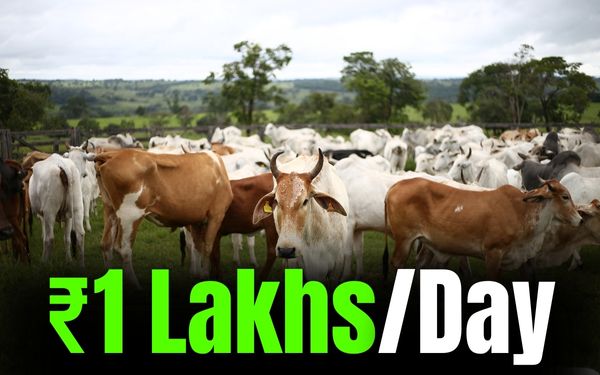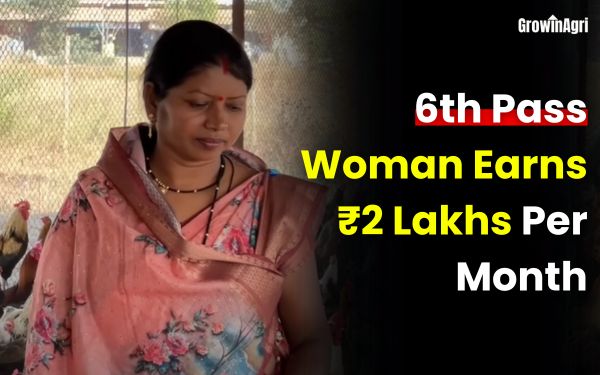How He Built ₹7–8 Crore Agriculture Empire
In this era, where most people’s chase urban dreams, Atul Pratap Singh chose a different path, he returned to his roots in Azamgarh, Uttar Pradesh. to build one of the most successful and modern farms in that region. His inspiring journey into poultry and fish farming has not only brought him accolades but also a flourishing agribusiness with an annual turnover of ₹7–8 crore.
Meet the Farm Owner
When Atul Pratap Singh was living in Delhi and preparing for the civil services Exam, Atul Pratap Singh had a conversation that changed everything. Motivated by a friend’s words, he chose to leave city life behind and return to his village in 2001 to pursue farming.
Balancing his job as a Hindi lecturer at Shri Vishwanath Inter College, Kalan, he took his first step into agriculture with 6,000 broiler birds, guided by expert training from CARI, Bareilly, and the financial support from his father, a doctor.
Fast forward to today, and Atul Pratap is running a large-scale operation with:
- 55,000 layer birds
- 35,000 broiler birds
- A 1-hectare fish pond
- Multiple crop plantations
Modern Agriculture Farm
Farm situated in a serene village in Azamgarh, the farm exemplifies a well-balanced integration of advanced agricultural infrastructure with the natural charm of rural India. The land, once unproductive and barren, has been meticulously developed to include a six-story, fully automated layer poultry facility, which reflects a strong commitment to technological advancement in livestock management.
In addition, the farm comprises separate units for broiler poultry production, a spacious pond designed for intensive fish farming, and a well-maintained farmhouse set amidst thoughtfully landscaped greenery. This strategic layout not only enhances operational efficiency and productivity but also fosters a clean, organized, and conducive environment for sustainable farm management.
Greening the Land, Naturally
Atul Pratap Singh’s deep-rooted love for nature is reflected in every corner of his farm. What once stood as dry, unused land has now blossomed into a vibrant green sanctuary. Rows of mango trees—Alphonso, Sinduri, Neelam, and Tota Pairi varieties. sway gently in the breeze, filling the air with a subtle, sweet fragrance. Scattered across the landscape are fruit-bearing plants like papaya, chakotra (pomelo), and sharifa (custard apple), offering both nourishment and beauty.
Hidden among them, like a secret treasure, grows a rare clove tree, alongside lush curry leaf plants, adding a touch of spice and tradition. More than just a place of production, the farm feels alive, a thriving ecosystem where agriculture and nature exist in perfect harmony.
Fish Farming Done Right
Among Atul Pratap Singh’s earliest and most innovative ventures was fish farming, a project born out of thoughtful land utilization and a keen eye for opportunity. Spotting a low-lying, underutilized patch on his land, Atul decided to turn it into something valuable. He excavated the area to create a one-hectare pond, simultaneously using the soil to raise the surrounding land for better usability. This smart move laid the foundation for a thriving aquaculture system.
With the help of aerators, Atul adopted intensive fish farming techniques, achieving impressive yields of 80 to 100 quintals of fish annually. Nothing on the farm goes to waste. Poultry litter from his nearby units is recycled as organic manure for the pond, enriching the water and reducing input costs. His model has become a learning ground for many local farmers, who regularly visit the farm, adopt his practices, and benefit from his guidance.
In recognition of his innovative and sustainable approach, Atul received the First District Award for Fish Farming in Azamgarh back in 2001—a proud milestone that marked the beginning of his journey as a visionary farmer.
Recognized and Respected
Atul Pratap Singh’s dedication and innovation in farming have earned him well-deserved recognition over the years.
In 2001, he was honored with the First Award for Fish Farming in Azamgarh, A testament to his early success in aquaculture. More recently, he received the First District Award for Poultry Production, further cementing his reputation as a leader in modern, efficient farming practices.
Today, Atul stands as a source of inspiration for both aspiring and experienced farmers throughout the region, proving that with vision and persistence, rural success stories are not just possible-they’re powerful.
His Philosophy: Farming with Joy, Not Just Duty
What truly sets Atul Pratap Singh apart isn’t just his success, It’s his mindset. For him, farming is not a burden but a joy, something to be embraced with heart and soul. He believes that true results come when you care deeply, especially when it comes to tending to livestock, watching them closely, understanding their needs, and nurturing them with attention and respect. Atul often speaks about the value of reconnecting with one’s roots, of returning to the land that raised you and making it thrive again.
His journey is a reminder that prosperity doesn’t always lie in the cities, It can be cultivated right at home, in the soil beneath your feet.
Above all, Atul credits his success to patience, dedication, and a relentlessly positive outlook, Qualities that have carried him through challenges and helped him turn a simple village farm into a model of modern rural entrepreneurship.
Atul Pratap Singh’s journey stands as a powerful testament to what farming can truly become-modern, profitable, and deeply fulfilling. He didn’t just raise poultry or harvest fish; he nurtured a dream, built a life rooted in purpose, and shaped a thriving agricultural enterprise from the ground up. With every step, he redefined what rural success looks like.
More than anything, Atul’s story lights a path for the next generation, Showing them that farming isn’t just an age-old tradition, but a dynamic force for change, innovation, and prosperity. His fields may be in a quiet village, but his vision reaches far beyond; Inspiring others to return to the land, reimagine its potential, and grow something far greater than crops.












